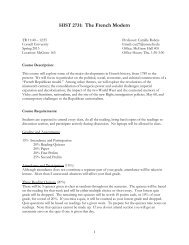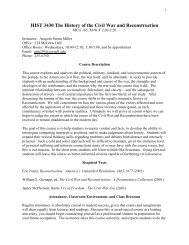VaultinG - Cornell University Department of History
VaultinG - Cornell University Department of History
VaultinG - Cornell University Department of History
Create successful ePaper yourself
Turn your PDF publications into a flip-book with our unique Google optimized e-Paper software.
6. Exude Confidence.<br />
The lunger and vaulters should always stand with proper posture—<br />
standing tall, core engaged, and chin lifted. Vaulters should approach<br />
the horse with their heads and eyes up. This gives the judge the<br />
impression that something good is about to begin, and they will sit<br />
up and pay more attention to your performance.<br />
7. Practice Good Horsemanship.<br />
Good horsemanship is the result <strong>of</strong> hundreds <strong>of</strong> hours <strong>of</strong> practice<br />
and work at home. The horse and lunger should be focused only<br />
on each other—an effective lunger and an obedient horse give the<br />
impression <strong>of</strong> experience. Lungers should put the horse out on the<br />
circle quietly and efficiently, making sure the lunge line is straight<br />
and untwisted. The horse should trot calmly until given the cue to<br />
canter (or continue trotting as the case may be) and should stay<br />
out on the line with good contact, a regular circle size, and a regular<br />
tempo throughout the performance. Lungers should attempt to<br />
stand in one place while lunging and avoid too much walking<br />
around. All lunger aids should be subtle—avoid wild whip waving,<br />
loud whip cracking, and jerking on the lunge line with each stride,<br />
for example. Avoid having a buddy horse standing by on the side <strong>of</strong><br />
the ring. Although buddy horses are not illegal, per se, the necessity<br />
<strong>of</strong> having one sends the message that the horse in the arena is not<br />
well trained and perhaps not a safe mount for the vaulters.<br />
8. Don’t Waste Time.<br />
Make sure everything is set to go before entering the competition<br />
arena. Avoid adjusting equipment after entry unless safety or<br />
common sense demands it. Although the horse and vaulter warmup<br />
is legal by the rulebook, it is considered by most judges to be<br />
a waste <strong>of</strong> time and an over-use <strong>of</strong> the horses. For me personally,<br />
the first time a horse comes into the arena, I am comfortable with<br />
a warm-up. After that, I consider it a “lunger” warm-up, and I lose a<br />
small amount <strong>of</strong> respect for the trainer, especially if a warm-up is<br />
taken every time the horse comes into the arena—whether it’s twice<br />
or twenty times. While many say that this is a safety issue, that again<br />
is a message to the judge that the horse is not well trained and<br />
perhaps should not be in the arena at all. (There can be exceptions<br />
to this depending on outside conditions. The<br />
judge is always agreeable to making sure <strong>of</strong> safety,<br />
so use common sense.)<br />
9. Know the Rules.<br />
During Compulsories, both Team and Individual,<br />
there is no bell between vaulters. Do not wait<br />
for the bell, because if the judge is following the<br />
rules, there won’t be one. It is best to pick one<br />
piece <strong>of</strong> music for all vaulters during a particular<br />
compulsory go. Music is not part <strong>of</strong> the score<br />
for compulsories, and too many music changes<br />
between vaulters can be distracting to the judge,<br />
and can interrupt the flow <strong>of</strong> the competition.<br />
The above information is, again, one judge’s<br />
opinion, and the truth is there are no rules you<br />
will be breaking by disregarding any <strong>of</strong> the above.<br />
However, each time you enter the arena you are<br />
giving the judge visual messages. If your tack or<br />
Photo courtesy <strong>of</strong> Primo Ponies Photography<br />
Exude confidence! Joanne and John Eccles <strong>of</strong> Great Britain looking poised<br />
before beginning a winning freestyle at the 2010 World Equestrian Games.<br />
horse are not clean, if your lunger is dressed too casually, if your vaulters<br />
run in haphazardly and line up gazing <strong>of</strong>f into the distance and avoiding<br />
eye contact, the message is one <strong>of</strong> lack <strong>of</strong> respect for the sport and/or<br />
the judge. Judges are trained to begin judging when the vaulter touches<br />
the grips (in all but the Team Event), but in the competitive world, every<br />
attention to detail adds value to your performance. Good luck!<br />
Interested in discussing this article with others in our vaulting<br />
community? Do you have a question, a comment, or an alternate point<br />
<strong>of</strong> view? Let’s “talk”! Go to the AVA members-only website, click on<br />
Forums (your same user name and password) and then find the section<br />
for Equestrian Vaulting magazine. Click on the article title and join in or<br />
start a dialogue with other members about what you just read!<br />
About the Author: An AVA judge since 1990, Suzanne Detol became an FEI “O” judge in 2001, and<br />
is well respected in the international judging arena. She is on the AVA board <strong>of</strong> directors, and is the<br />
organization’s Medal Test Secretary and Competitions Secretary.<br />
Show <strong>of</strong>f that elegant discipline! Team Germany saluting Judge A at the 2010 World Equestrian Games.<br />
Photo courtesy <strong>of</strong> Primo Ponies Photography<br />
www.americanvaulting.org 25





